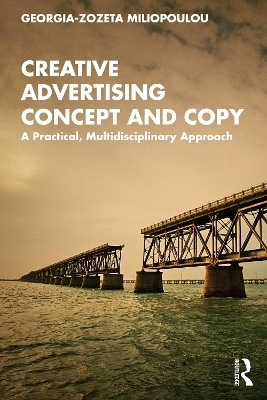
Creative Advertising Concept and Copy
Routledge (Verlag)
978-1-032-36204-5 (ISBN)
Drawing from diverse subject areas including Social Anthropology, Narrative Theory, Consumer Psychology, Semiotics and Cultural Studies, Creative Advertising Concept and Copy provides a solid grounding in advertising education away from the traditional business and marketing literature. Notwithstanding the need for independent inspiration and originality, the author guides readers through the entire process of campaign planning, moving from strategy to creative idea to finished piece whilst employing concepts and principles relevant to ‘design thinking’. Taking into account ethics and regulations, the use of text and images, and storytelling across radio, TV and video platforms, readers will come to a holistic understanding of what advertising can (and cannot) do, and how to achieve the best results.
Written for students involved in creative advertising as an area of academic research and professional practice, this book will also be of interest to early-career advertising professionals seeking a fresh perspective on their work.
Georgia-Zozeta Miliopoulou is Associate Professor in the Department of Communication at Deree, The American College of Greece. She has over 25 years of experience in creative advertising and holds a Ph.D. in brand communication. She has been teaching creative advertising and new media since 2003 and still offers workshops for communication professionals. Her research interests include creativity, strategic content & storytelling, and the managerial aspects of creative agency work.
About the author
Preface
Acknowledgements
1. Advertising: bridging the economic and social sphere
1.1 Advertising studies
1.2 Advertising: definition and scope
1.3 The product and the brand; marketing and advertising.
1.4 The practice of advertising in steps
1.5 The creative brief and the outline of the book – a parallel structure
1.6 What is not in this book.
2. Objectives and effects: What advertising can (and cannot) do – and how to plan for results
2.1 Introduction
2.2 Think - Feel - Do: How advertising sets its objectives.
2.3 From consumers to brands
2.4 Arriving at sensible and plausible objectives
2.5 Measurements and metrics
2.6 The unintended effects of advertising
2.6.1 Shopping for meaning in the symbolic marketplace.
2.6.2 Who’s in, who’s out? Advertising representations
3. Audiences and consumers: How people read products and consume ads. How ads read people.
3.1 How people read products and consume ads
3.2 Basic semiotics
3.2.1 The sign
3.2.2 Denotation & Connotation
3.2.3 The metaphor
3.2.4 Encoding and decoding
3.3 How to read through an ad.
3.4 How ads read people.
3.4.1 STP
3.4.2 Dividing and classifying
3.4.3 The STP challenges
3.5 Tools to understand people.
3.5.1 Customer journeys
3.5.2 Customer personas
3.6 Insights
3.7 The role of big data in creative advertising
4. The creative idea in practice and in theory
4.1 Introduction
4.2 Creativity: a context-specific definition
4.3 Creative advertising: the product
4.4 From an idea to a campaign: elements of synergy & integration
4.5 Creative advertising: the agency process
4.6 Connecting practice to theory.
4.6.1 Divergent and convergent thinking in creative advertising
4.6.2 Fluency, flexibility, originality
4.6.3 Preparation, incubation, illumination, verification
4.7 Creative advertising compared to creative problem solving and design thinking
4.8 Tools & techniques for advertising creativity – towards a modus operandi
4.8.1 Automatic writing – free associations
4.8.2 Forced connections
4.8.3 Consumer and brand prompts
4.8.4 SCAMPER
4.8.5 Brainstorming / Brainwriting
4.9 The everyday life and the cliches of the creative advertising professional
4.9.1 The creative genius and the team
4.9.2 The Ps of creativity in the agency
4.9.3 Soft skills
4.9.4 Deadlines, stress, risks, and incentives
4.9.5 The need for diversity and management
4.9.6 Compartmentalisation
5. Text and image combinations: print, outdoor, post, meme
5.1 Introduction
5.2 Anchoring
5.3 Rhetorical figures
5.3.1 Rhetorical schemes
5.3.2 Rhetorical tropes
5.4 Visual rhetoric and combinational creativity
5.5 Copywriters and art directors in tandem: working in a creative ad agency
6. Storytelling: creating TV, radio, and video ads
6.1 Introduction
6.2 Narrative theory: a brief overview
6.3 Narrative tools.
6.4 Writing the TV script.
6.5 Types of TV advertising
6.6 Writing for the radio or for podcasts
6.7 Transmedia storytelling and advergames
7. What creatives need to know about media planning
7.1 Introduction
7.2 Paid, owned, earned media
7.3 Media planning in traditional media – key terms
7.4 Media planning in traditional media – selecting the appropriate mix.
7.5 Display ads on the web and social media
7.6 A few words on programmatic advertising.
7.7 A few words on social media advertising
7.8 Conversions and connections
7.9 Integrated and omnichannel campaigns.
7.10 Local, global, glocal – in the context of new media
7.11 Creative use of media
8. Content Marketing: new media, familiar patterns
8.1 Branded content and content marketing
8.2 Engaging through content: three approaches
8.3 Content marketing & product category
8.4 Content strategy and planning in steps
8.5 Branded content – pillars & formats
8.6 Content calendars
8.7 Metrics & KPIs
8.8 A few words on virality
8.9 Is the King dead?
8.10 “OK, Boomer”
9. Ethics & regulations in advertising
9.1 Introduction
9.2 Self-regulation in a nutshell
9.3 Some key ethical issues.
9.3.1 Product category related regulations.
9.3.2 Advertising regulations across categories
9.4 Improving one ad at a time: the message and the claim.
9.5 Considering ads as a whole - Some key issues.
9.6 Power relations between brands and consumers.
9.7 Considering ads as a whole: your moral compass
9.8 Normative ethics and deontology
Index
| Erscheinungsdatum | 10.04.2024 |
|---|---|
| Zusatzinfo | 18 Tables, black and white |
| Verlagsort | London |
| Sprache | englisch |
| Maße | 156 x 234 mm |
| Gewicht | 390 g |
| Themenwelt | Geisteswissenschaften ► Geschichte |
| Sozialwissenschaften ► Kommunikation / Medien ► Medienwissenschaft | |
| Wirtschaft ► Betriebswirtschaft / Management ► Marketing / Vertrieb | |
| Wirtschaft ► Volkswirtschaftslehre | |
| ISBN-10 | 1-032-36204-9 / 1032362049 |
| ISBN-13 | 978-1-032-36204-5 / 9781032362045 |
| Zustand | Neuware |
| Haben Sie eine Frage zum Produkt? |
aus dem Bereich


